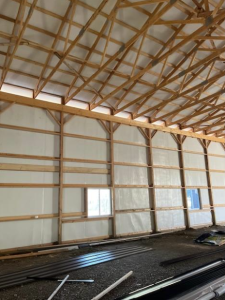Ceramic Insulation
In the 1990’s I owned Momb Steel Buildings in Spokane. We provided pole building packages and also constructed post frame buildings from a bricks and mortar location.
As the sales team grew in size, we would have weekly meetings for educational purposes. The resultant of these became known as “stump the expert” (aka me). It wasn’t very often the crew could slip one by me.
Eric, one of the owners of Hansen Pole Buildings, caught me with a curveball on Monday, as he innocently asked me what I knew about spray on ceramic insulation. The sum total of my knowledge base equaled….zip…zero…nada.
Knowing Eric (and him knowing me), I’m sure he knew this would set me off on a wild flurry of Google searches. Which it did.

The ceramic insulation concept resulted from pre-owned steel shipping containers being converted to other uses, primarily housing. One of the major problems of these containers is insulation. The inside dimensions are fairly small, so furring them in and adding insulation leaves very little space. Insulate the outside and the shipping container look goes away, which IMHO (in my humble opinion) is a distinct plus, but some folks like the industrial look.
The supplier of the spray or paint on ceramic insulation claims the product addresses all three modes of heat transfer – radiation, convection and conduction. They also call “R-Values” (the standard measure of insulation) a “fairy tale”, which seemingly would result (if true) in throwing out most of the science of insulation.
On the Environmental Protection Agency Energy Star website it states, “EPA does not recommend paints and coatings be used in place of traditional bulk insulation. We haven’t seen any independent studies which can verify their insulating qualities.”
Alex Wilson at Building Green writes “To say that there is a lot of hype about insulating paints and radiant barrier coatings is an understatement. The Internet is rife with claims of paints that dramatically reduce heat transfer–usually based on some technological magic spun off from NASA. While these products may have some relevance in the extreme conditions of outer space, manufacturers of paints containing “ceramic beads” or “sodium borosilicate microspheres” are making claims that defy the laws of physics–and independent test results–when they claim they can save significant energy in buildings.”
In actual practical use – the ceramic insulation turns out to be effective against radiant heat from direct sunlight, as well as to keep heat from a radiant heater inside. However it proved to be useless for preventing condensation or for maintaining any sort of interior comfort level. Trying to keep the inside warm in winter? Turn off the heat source and the space immediately becomes cold.
The reality is, ceramic insulation (either spray or paint on) falls into the realm of being a radiant barrier. This being said, a single R-value does not describe a radiant barrier very well, as the insulation effect is very dependent on how it is used. There is, however, a technical parameter which describes the performance of a radiant barrier well, emissivity. One ceramic insulation product lists the emissivity as being from 0.21 to 0.36, which is somewhat better than most plain paint. However, it is nowhere near as good as a foil radiant barrier, which has emissivity of 0.03 to 0.05.
For a pole building….my recommendation would be to run, do not walk, away from any consideration of a ceramic insulation as being a practical solution for controlling interior climate, or condensation issues.






